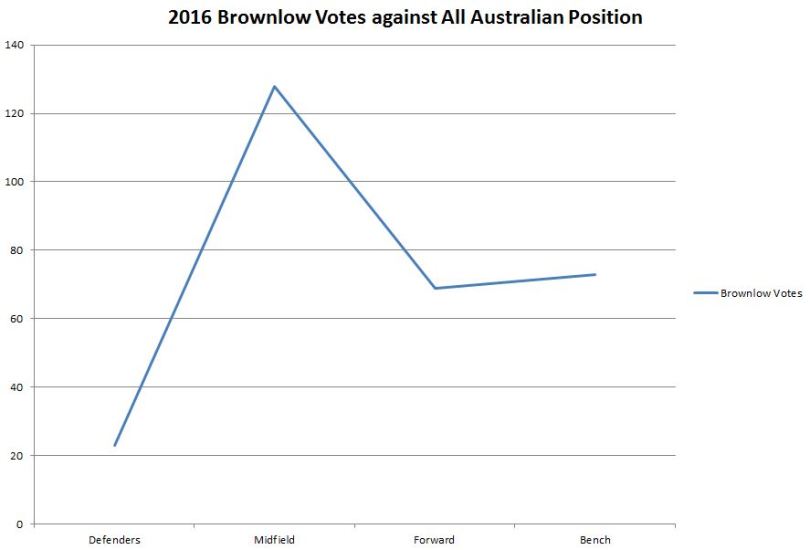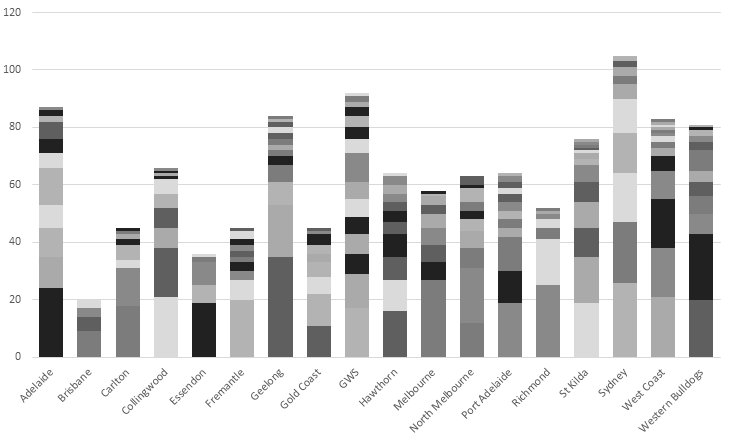Our post earlier this week looked at the inevitability of Patrick Dangerfield winning the Brownlow Medal. Which, unsurprisingly to most who were paying attention to football in 2016, ended up happening in a landslide.
We thought that Dangerfield would get about 34.5 votes, assuming that he picked up an average of 2.3 votes in games which the Cats won and he gathered more than 28 disposals. In reality, Dangerfield ended up with 35 votes, however he failed to get votes in a couple of games that met this criteria, shaded by better teammates (Guthrie in a career best performance and Selwood) or stellar performances by opponents in close games (Lachie Whitfield in round 11).
The post also looked at the likelihood of a forward having a shot at the medal, and their polling potential this season. HPN predicted that the Eagles’ Josh Kennedy and Lance Franklin would get 17 votes each, one off their eventual totals. For the lesser forwards, the predictions were less accurate (especially for Tom Hawkins) but generally in the ballpark.
One area we neglected to look at is the failure of the umpires to consider the contributions of the elite defenders of the game. Here is a chart looking at the total votes in this year’s Brownlow Medal for this year’s All Australian Team, broken down by nominated position:

When we looked at that we were a little bit surprised. Had it always been like this? Didn’t Wanganeen once win a Brownlow from the back pocket.
It’s worth noting that the four bench players (we added Boyd into “Bench” for argument’s sake, but his two votes don’t make a difference either way) got more than three times the number of votes as the six defenders.
Intuitively this makes sense to some degree because a defenders’ biggest contribution is often to negate the contributions of their opponents, with any positive contributions usually ancillary to their main role. However it does indicate that a significant part of the game is being overlooked by the current voting system.
We decided to have a look at the past six years of All Australian defender Brownlow Medal votes, to see if there was a consistent trend. We’ve categorized some bench players as defenders where their role is clearly that (such as Matthew Boyd this year). As such, some years have seven defenders, and some have six. For fun, we decided to also plot the Brownlow Medalist’s votes against this group of six (or seven) elite players:

DEFENDERS GET NO RESPECT. In this small sample in just two years did the best defenders in the land cumulatively receive more votes than just one player. In both 2010 and 2013 the All Australian teams had midfielders masquerading as defenders more than a spike in the votes for most defenders. For example, in 2013 both Sam Mitchell and Jarrad McVeigh were named as defenders, and were responsible for 29 votes between them. Whilst they both can play defence, a balanced team probably wouldn’t line up with both in the backline. Similarly, in 2010, Goddard was named off half-back, where he played occasionally but he was more a midfielder.
How did each club do?
Below is a graph of vote-getters by club, stacked to show each club’s total votes as well.
Sydney’s leading vote-getters all individually did quite well, but probably took too many votes off Luke Parker for him to be a threat. By contrast, Lachie Neale and Nat Fyfe got over half of Fremantle’s total votes between them. Likewise for Geelong, with Dangerfield and Joel (certainly not Scott) Selwood getting more than half their team’s votes.
The degree of vote concentration among leading players at each club can be seen here.

GWS had the widest spread of votes across the list in 2016, with aAdelaide and the Bulldogs also having multiple players snag votes. All three sides are successful teams with a relatively even spread of workload from game to game.

